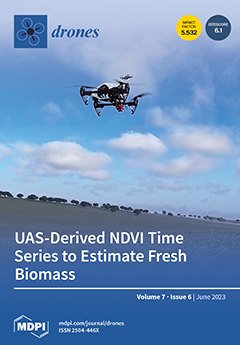In recent years, UAV remote sensing has gradually attracted the attention of scientific researchers and industry, due to its broad application prospects. It has been widely used in agriculture, forestry, mining, and other industries. UAVs can be flexibly equipped with various sensors, such
[...] Read more.
In recent years, UAV remote sensing has gradually attracted the attention of scientific researchers and industry, due to its broad application prospects. It has been widely used in agriculture, forestry, mining, and other industries. UAVs can be flexibly equipped with various sensors, such as optical, infrared, and LIDAR, and become an essential remote sensing observation platform. Based on UAV remote sensing, researchers can obtain many high-resolution images, with each pixel being a centimeter or millimeter. The purpose of this paper is to investigate the current applications of UAV remote sensing, as well as the aircraft platforms, data types, and elements used in each application category; the data processing methods, etc.; and to study the advantages of the current application of UAV remote sensing technology, the limitations, and promising directions that still lack applications. By reviewing the papers published in this field in recent years, we found that the current application research of UAV remote sensing research can be classified into four categories according to the application field: (1) Precision agriculture, including crop disease observation, crop yield estimation, and crop environmental observation; (2) Forestry remote sensing, including forest disease identification, forest disaster observation, etc.; (3) Remote sensing of power systems; (4) Artificial facilities and the natural environment. We found that in the papers published in recent years, image data (RGB, multi-spectral, hyper-spectral) processing mainly used neural network methods; in crop disease monitoring, multi-spectral data are the most studied type of data; for LIDAR data, current applications still lack an end-to-end neural network processing method; this review examines UAV platforms, sensors, and data processing methods, and according to the development process of certain application fields and current implementation limitations, some predictions are made about possible future development directions.
Full article





